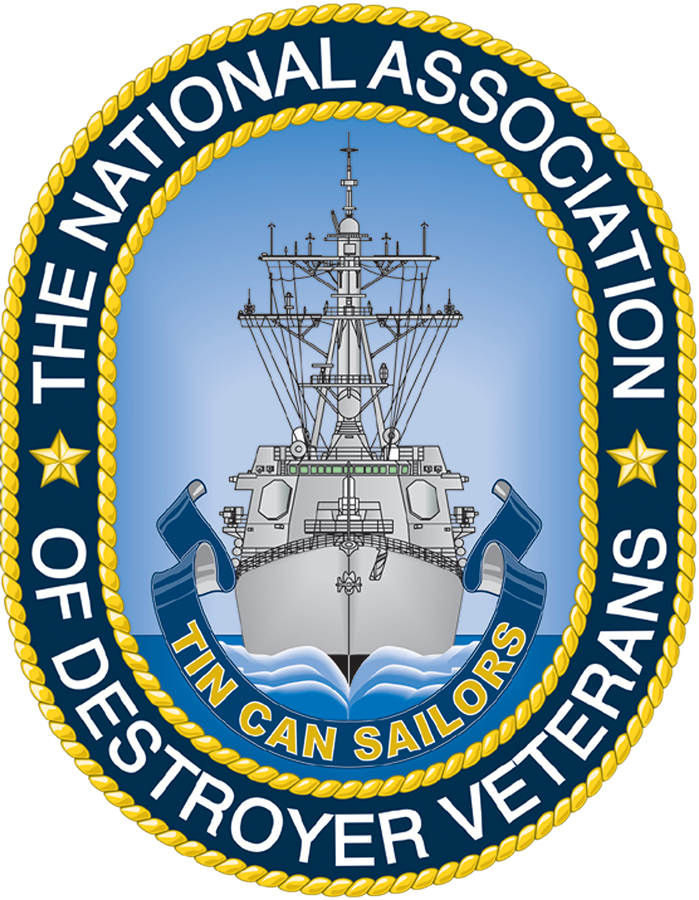USS HARADEN DD-585 Ship History
Dictionary of American Naval Fighting Ships, July 2015
The second Haraden was launched by Boston Navy Yard, Boston, Mass., 19 March 1943; sponsored by Miss Caroline E. Derby, great-great-grandniece of Captain Jonathan Haraden; and commissioned at Boston 16 September 1943, Comdr. H. C. Allen, Jr., in command.
Haraden departed Boston 9 October 1943 for shakedown training off Bermuda, and after its completion joined carrier Intrepid at Boston 30 November for the voyage to the Pacific. She transited the Panama Canal and arrived San Diego 21 December to join Rear Admiral Oldendorf’s Northern Support Group for the epic invasion of the Marshall Islands.
Escorting the main attack group of transports, Haraden arrived in the Marshalls 30 January, and was detached to form a screen for the battleships and cruisers during the heavy bombardments of 31 January. As troops landed under the devastating fire on Ennubir Island, Haraden shifted to direct flre support, turning her guns on an ammunition dump on Ennagannet Island that soon blew up with a tremendous explosion. That night she conducted anti-submarine patrol and 1 February continued fire support and patrol functions during the landings on Roi and Namur. The destroyer departed the Kwajalein area briefly for an escort volage to the Ellice Islands 6-15 February, but returned to provide anti-submarine patrol for units off Kwajalein and Eniwetok until 29 February.
Haraden arrived Pearl Harbor 8 March 1944, and after a brief period of upkeep steamed back to the Marshalls with two fleet oilers carrying vital fuel. Arriving 1 April, she engaged in various duties in support of the operations there, including fire support and anti-submarine patrol, until departing for Pearl Harbor with escort carrier Bataan 18 May. At Pearl Harbor Haraden was reassigned to escort carriers Natoma Bay and Manila Bay and repair ship Hector for the next major operation in the epic sweep through the Pacific, the Marianas.
Arriving east of Saipan 22 June 1944, Haraden screened her escort carriers during the launching of aircraft 22-24 June; while refueling alongside Natoma Bay she narrowly missed being sunk by four aerial bombs in a surprise attack. Two bombs fell some 200 yards to port and two astern. Haraden returned to Pearl Harbor, arriving 8 July, until 15 September participated in training exercises and maneuvers in Hawaiian waters in preparation for the invasion of the Philippines.
Haraden arrived Seeadler Harbor, Manus, Admiralty Islands, 2 October 1944, and 12 days later departed as an escort unit for the large group of transports carrying invasion forces. They arrived off Leyte 20 October and Haraden began a long and grueling job of covering the transports during and after the main assault. Japanese airplanes began almost continuous raids on the landing group the afternoon of 20 October, with Haraden acting as part of the antiaircraft screen, protecting the transports with her gunfire.
The afternoon of 26 October Haraden formed with an escort carrier group in Leyte Gulf and steamed for Manus, arriving Seeadler Harbor 1 November 1944. Remaining there until 12 November, the ships sailed to Palau, arriving the 18th, and from there provided air support to convoys bound to and from the Philippines until 28 November. The carrier force, with Haraden in the screen, departed 10 December for the Sulu Sea, en route to the invasion of Mindoro.
Haraden and the escort carriers entered the Sulu Sea 13 December, and were attacked that day by four Japanese aircraft. Haraden assisted in downing three of the raiders, but the fourth banked left and dived for the destroyer. Trailing smoke from hits by Haraden’s gunners, she crashed into the destroyer’s side, putting her forward engine room out of commission and severely damaging her topside. As Haraden lay dead in the water, destroyer Twiggs came alongside to help and the destroyer was soon underway on her own power. She arrived at San Pedro Bay 14 December 1944 and transferred her casualties-14 killed and 24 wounded. Steaming on toward the United States via Hawaii, she arrived at Puget Sound Navy Yard, Bremerton, Wash., 14 January 1945 for battle repairs.
Repairs and training completed, Haraden departed again for the Pacific 19 April from San Francisco, arriving Pearl Harbor 25 April. She performed escort duties for amphibious convoys in the Western Pacific until 6 July, when she commenced a series of training exercises off Subic Bay, Philippine Islands.
Haraden next participated in the operations off the China coast following the surrender of Japan. She got underway 28 August with units of the 7th Fleet and made a show of force at Tsingtao and along the China coast to help stabilize the tense situation there. She arrived at Jinsen, Korea, 8 September and after another voyage down the coast of China and back, departed Jinsen with the North China occupation forces 29 September. She stood by to support the amphibious landings of occupation forces off Taku Bay 30 September-6 October, and visited Chefoo, Shanghai, Taku, and Tsingtao in support of the occupation. Underway from Tsingtao 13 December 1945, she steamd by way of Pearl Harbor to San Francisco, arriving 3 January 1946. Later moved to San Diego, she remained inactive until decommissioned there 2 July 1946. Haraden entered the Pacific Reserve Fleet, San Diego Group, where she remains.
Haraden received five battle stars for her service in World War II.
